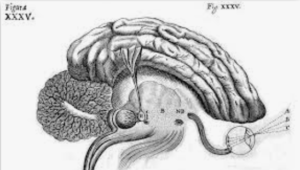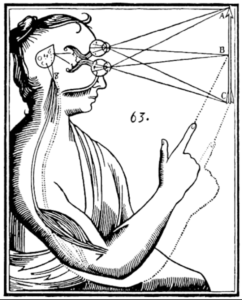Let’s get one thing straight:
Your mind and body are indeed connected.
Unfortunately, people in pain are often treated as broken parts. This is not your fault. You are not broken. Our healthcare system, however, could use a bit of repair…
You’ve heard my thoughts on the Cartesion Model of Pain in Pain Part 1: Enter the Matrix and Pain Part 2: Befriending Pain. Turns out, beloved philosopher Rene Descartes also had a part in the splitting off mind from body with his declaration,
“I think, therefore I am.” 
We’ve gone so far as to value our minds so much that our bodies sometimes go neglected — our minds get constant attention while our bodies often sit all day as our brains go to work.
Is your body letting you know it feels neglected?
It may seem that I’m riding high on my horse that looks like a bike desk (no really, I’m pedaling as I type,) but I do have first-hand experience here. When I transitioned from full-time work as a fitness instructor to sitting for long hours to study as a PT student, I developed chronic neck pain and migraines. Perhaps it’s ironic that in studying the reasons why people are in pain, my body was trying to send me a message loud and clear:
“You are embodied. Please pay attention to this thing attached to your brain.”

It is a constant challenge in this world that so values our highly developed minds. But evidence continues to point to the ways that mind and body co-exist and interrelate in complex ways that may have Descartes stirring in his grave. Some mind-blowing (pun intended) studies have found:
- Changes in the structure and function of the brain and nervous systems of people who experience persistent (bodily) pain
- 8 weeks of meditation changes the structure of the brain, increasing the mass of gray matter in areas related to sense of self
- Improved ability to sense the body (right from left) seems to reduce chronic pain
- The mind map of the body is always changing, and dramatic shifts are seen when we use our bodies differently
- Older adults who start a meditation practice are able to improve physical function and reverse signs of aging
So let’s get to re-connecting the mind and body. I’ll start by sharing an audio recording of a guided meditation courtesy of my coursework in iRest, which is short for Integrative Restoration. Studies have found that iRest improves symptoms of chronic pain, anxiety, insomnia, and post-traumatic stress.
I invite you on this journey of integrating thoughts, beliefs, and bodily sensations into your awareness. As with anything I offer, I hope you will take what works for you and leave the rest (feel free to tune me out at times in order to you dive into the practice and make it your own.)
Also, there is no need to contort into lotus pose for this meditation. Find a comfortable, supported position and feel free to adjust as needed throughout the practice.
Notice any shifts, large or small, that occurred during your practice. Observe any response in your body or mind. Reflect on your experience, in a journal, or feel free to share in the comments below.
